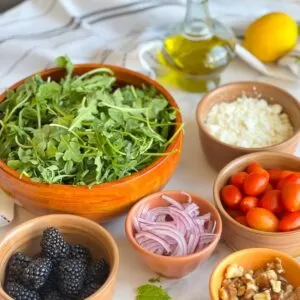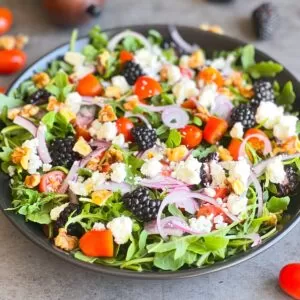Arugula Salad with Goat Cheese


Arugula Salad with Goat Cheese
Description
Enjoy this flavorful arugula-goat cheese salad that comes together just in minutes!
If you are a salad person like me, this recipe is nutritious, satisfying, and very easy to try! You will absolutely love the delicious combination of the flavors of arugula, goat cheese, and tomatoes.
Goat cheese comes in a wide variety of flavors and textures, from soft and spreadable fresh cheese to salty, crumbly aged cheese. We will go for the crumbly plain goat cheese for this recipe. You can be more creative and add different ingredients for the best goat cheese salad recipe according to your taste and to the season.
Ingredients
Preparation
-
In a serving bowl, combine arugula, red onion, cherry tomatoes, and blackberries.

-
Top with goat cheese and sprinkle with the walnut pieces.

-
Season with salt and pepper. Drizzle with olive oil and lemon juice.
Bon Appetit!

Note
1-The significance of finely dicing the onion:
Arugula has a peppery flavor that adds a great bite to dishes. Try it with any of the flavors like tomatoes, goat cheese, onions, avocados, beets, and nuts. But especially red onion has a sharp smell and taste. To enjoy all the flavors, keep in mind to put in finely diced onions for a balanced dish.
2-Assembling of ingredients just before serving:
Prepare and store all the salad ingredients individually in the fridge. Mixing everything and adding the salad dressing just before serving is the best way to keep your salad fresh and crisp.
3-Right way of doing salad dressing:
The first rule is to add the salad dressing just before serving.
Adding too much dressing can mask all the flavors of your salad.
Oil, acid, dijon mustard, and sugar are the key components of a delicious salad dressing.
For evenly distributed salad dressing, drizzle your dressing along the walls of your bowl, then lightly toss your salad until the dressing is evenly distributed.
4-Serving and additional variations:
You can keep your leftover salad in the fridge for a few days. You might notice a bit of sogginess depending on the ingredients you use. Put it in an airtight plastic container lined with a paper towel so the paper towel will absorb any excess water.
Frequently Asked Questions
Goat cheese, goat's cheese, or chèvre or; from French fromage de chèvre "goat cheese", is cheese made from goat's milk.
Goat cheese is low in calories, fat and has less sodium than feta. One ounce of soft goat cheese contains 76 calories, 6 g of fat, and 130 mg of sodium.
There are a variety of things that can be paired with goat cheese. Some popular options include fruits such as figs, apricots, or pears; nuts such as almonds, walnuts, or pistachios; or honey. Crackers or breads such as baguettes or sourdough are also common accompaniments.
Mozzarella has a comparatively lower calorie content when compared to goat cheese. Therefore, if you wish to limit your calorie intake, mozzarella is a better choice.
Goat cheese is richer in Copper, Vitamin A RAE, and Vitamin B2, yet Mozzarella is richer in Calcium, Vitamin B12, Zinc, Selenium, and Phosphorus.
Daily need coverage for Copper from Goat cheese is 60% higher.
Goat cheese contains 26 times more Sodium than Mozzarella. Goat cheese contains 415mg of Sodium, while Mozzarella contains 16mg.
Goat's cheese is extremely versatile and can be served hot or cold, no option is better than the other. But it is best to serve at room temperature, so take it out of the fridge 30 minutes before serving.
Yes, you can eat goat cheese raw. It has vitamins, minerals, enzymes, protein, fatty acids and more that are waiting to nourish your body with easier digestion. While cow's milk has both A2 and A1 beta-casein proteins, goat cheese has only A2 beta-casein. The difference means that goat cheese and goat milk are easier to digestion.
Goat cheese is rich enough in flavor and creaminess to make a great accompaniment to crackers or bread, so you can eat it on its own.



